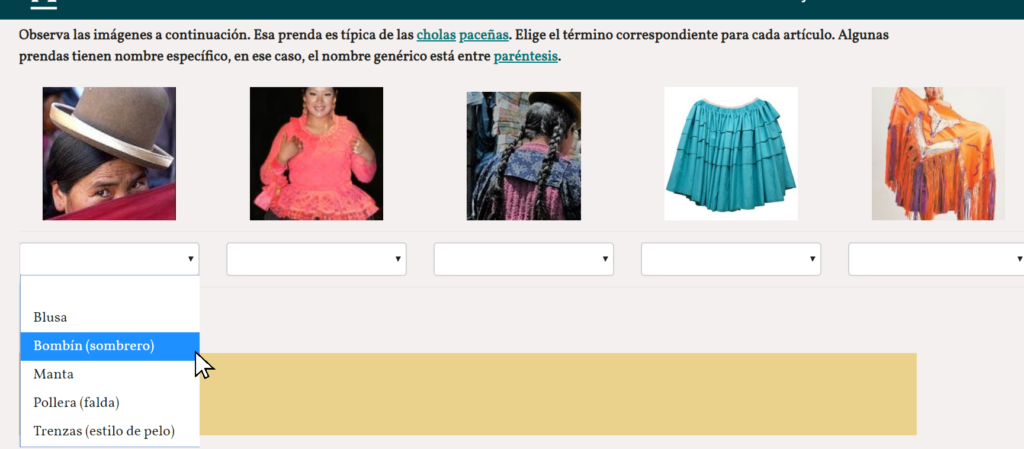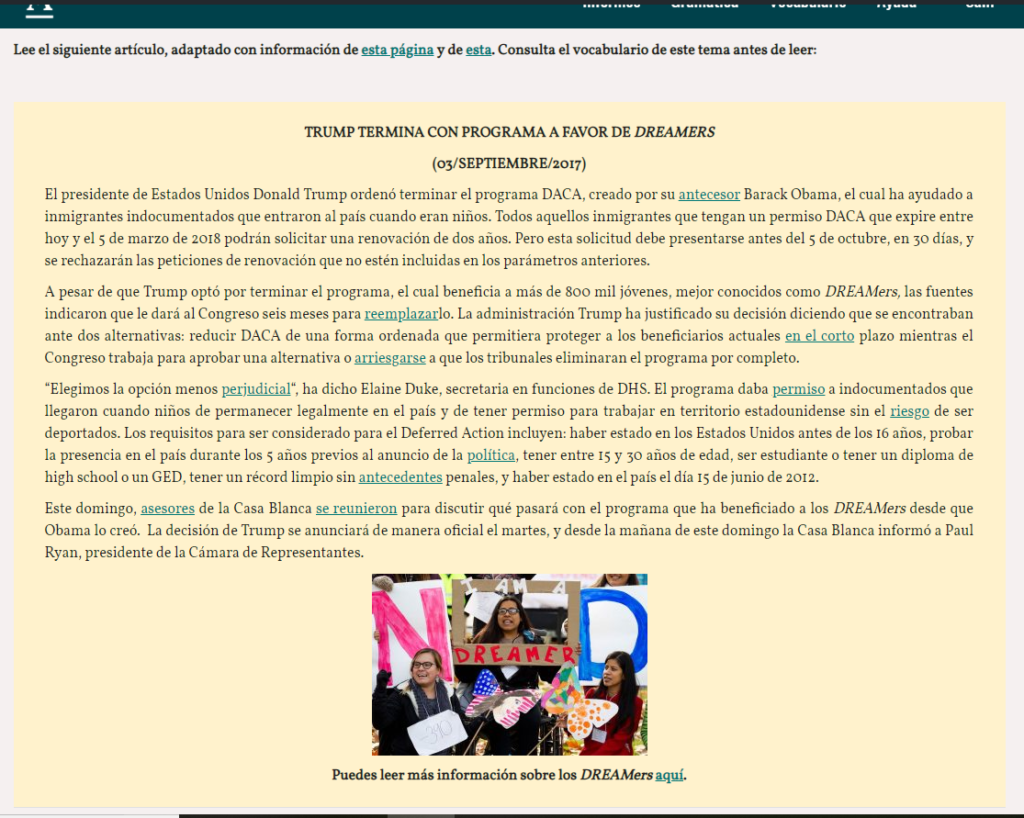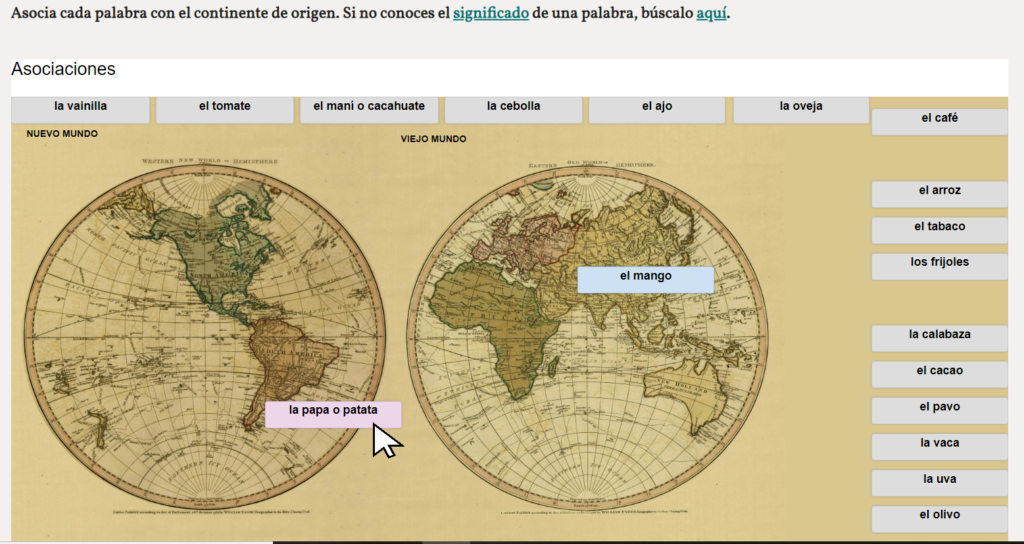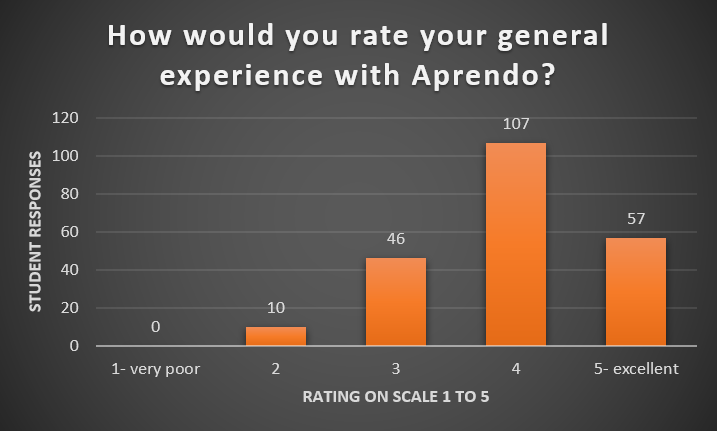Liberating Language Learning: An Online Platform as an Alternative to Traditional Textbooks

Andie Faber, lecturer, Department of Spanish and Portuguese, Princeton University, NJ
|

Anais Holgado-Lage, lecturer, Department of Spanish and Portuguese, Princeton University, NJ
|

Adriana Merino, lecturer, Department of Spanish and Portuguese, Princeton University, NJ |
Jovana Zujevic, lecturer, Department of Spanish and Portuguese, Princeton University, NJ |
DOI: https://www.doi.org/10.69732/FJCN3963
The limitations of textbooks and the benefits of technology in language teaching and learning have been consistent topics of conversation among linguists, language instructors, and, by extension, a few of our more motivated and critical students. Linguists have expressed their concern about “the gap between SLA research and textbook design” (Cubillos, 2014: 222), educators have pointed out that the “disconnected, noncommunicative presentation of language” is not conducive to discussing contemporary issues and tackling controversial topics (Herman, 2007: 121), and students have found textbooks expensive and their content outdated and mechanical. As teachers, critical and creative thinkers, and lovers of all things language and culture, we often experience frustration with the lack of flexibility that goes along with using textbooks, as well as their limited authentic input.
While textbooks have been scrutinized and criticized, the integration of technology in language teaching and learning has been encouraged and praised. Indeed, in the Spanish Language Program at Princeton University, we have had the opportunity to merge this overall dissatisfaction with textbooks and our enthusiasm for technology by creating a digital platform entitled Aprendo, which translates as “I learn.” In this article, we outline some of the essential characteristics of Aprendo and illustrate them with specific examples of activities that have so far enabled us to learn more about teaching with technology and our students to learn more Spanish more effectively.
As a custom-made and digital “living” textbook, the Aprendo project began in January of 2016 and was first implemented in Fall of that year in intensive elementary and intermediate Spanish classes at Princeton. Since its initial implementation in 2016, roughly 300 Princeton students study Spanish using this platform each year. One of the principal benefits of Aprendo is that it enables us to expose our students to a wide variety of authentic, multimedia content, which can be constantly updated, expanded and improved based on the needs of our university community and current issues in the Hispanic world. The materials reflect content-based language teaching and emphasis is placed on discourse analysis, intercultural competence, pragmatic and social interaction, and the development of learner autonomy. In line with the flipped classroom model, before coming to class, our students complete various activities by logging into Aprendo from their personal computers and are able to rely on technological tools and resources that allow for self-monitoring and correction. We then expand upon their homework and provide further practice in the classroom through activities that prepare them for everyday-life communication contexts.
So far, we have noticed that Aprendo has not only improved our students’ language skills, but also enhanced their critical thinking, creativity, and awareness of various issues in the Spanish-speaking world. In their course evaluations, many students make specific mention of the positive impact that learning culture along with language has had for them:
- “I definitely learned a lot about different grammatical and cultural aspects of Spanish I did not know before” (student in beginning Spanish)
- “I think the cultural aspects of Aprendo have been really helpful, especially the videos” (student in beginning Spanish)
- “The cultural activities are super super interesting” (student in intermediate Spanish)
- “The language and culture was taught through concepts that motivated a lot of important discussion and different perspectives on real-world topics that are applicable to what’s going on right now, and I found that very valuable” (student in intermediate Spanish)
- “The classes were very engaging, with the professor making sure to ask questions that required us to think critically” (student in intermediate Spanish)
Four essential characteristics of the platform lead to these desirable learning outcomes: it is content-based, authentic, customizable, and interactive. We will now briefly describe and illustrate each of these characteristics.
MAKING LANGUAGE MEANINGFUL
One of the major advantages of implementing an online platform in lieu of a traditional textbook is that it allows us to incorporate content that is of interest to ourselves and our fellow instructors. In this way, we teach students grammar, vocabulary, pragmatics, etc. by presenting relevant cultural content in the target language. Students engage with the language through meaningful and authentic interactions, even at initial levels of the acquisition process. For example, when studying clothing vocabulary, students reflect on the relationship between clothing and identity. They identify three pieces of clothing or accessories that represent aspects of their identity (e.g., a sweatshirt with their school logo or a necklace with a religious symbol). They then learn about the traditional dress of las cholitas paceñas, indigenous Aymara women of La Paz, Bolivia before reading an article adapted from El País about Aymara fashion designer, Eliana Paco, whose traditional cholita-inspired designs were recently featured at New York Fashion Week. In class, students discuss the similarities and differences they see between themselves and the cholitas in the way they use clothing to mark aspects of their identity. In groups, students discuss the importance of Eliana Paco’s show at New York Fashion Week and the role of representation in validating identity by first brainstorming a list of the positive impacts in Spanish, with guidance from their instructor, and then sharing these lists aloud with the rest of the class.

PRESENTING AUTHENTIC INPUT
Creating course material from authentic sources not only exposes students to new ideas and different cultural perspectives, but it gives them access to the way that the language is really used. Thus, instructors teach grammar, vocabulary, and communicative strategies in context in a way that helps students be more effective users of the language.
A common anecdote among second language speakers is that they spend years studying the language, only to step off a plane in a country that speaks the target language and realize that they are unable to understand a word that people are saying. This is not altogether surprising as for many years, language learners have been dependent on instructor speech and inauthentic textbook conversations for audio input, leaving them lost when they are thrown into real-world situations. Thanks to the internet, however, we now have a great deal of authentic audiovisual material available to utilize (there is a plethora of resources, from well-known sites like YouTube or Vimeo to sites such as ivoox, which allows you to search podcast episodes by topic in a number of languages).
The Aprendo platform allows for us to incorporate these materials into our courses and scaffold them in a way that allows students not only to hear more authentic use of the language but to learn how to listen and pull out the key message in a discourse. As a case in point, to practice command forms and vocabulary related to the environment, we take a four-minute Spanish-language podcast about caring for the environment and edit it using Audacity so we can present it in short, manageable segments. Students then answer targeted questions to practice listening skills. If the students were to listen to the full four-minute podcast unaided, they would likely find it very difficult to understand. However, by presenting it in segments and asking questions related to the main concepts for each fragment, students are able to comprehend quite a bit. Students recognize the value of listening to Spanish spoken for native speakers by native speakers; one student commented “The ability to watch videos in Spanish was one of the most positive aspects of Aprendo because it really helps students develop an ear for understanding Spanish and the speed at which it is spoken”.
CREATING CUSTOMIZABLE CONTENT
Another relevant characteristic of an online platform is the possibility of customization, not only during the design period but also regularly between semesters. One of the principal inspirations for the creation of this project is the specific profile of Princeton University students, who are often interested in current issues and not the traditional topics that appear in many textbooks. With that in mind, we personalized Aprendo and tailored it to this particular type of user, so that it connects with the life and experiences of our students. For example, in the intensive intermediate course, there is a unit about immigration and immigration policies. In this unit, students watch a video interview with a Princeton undergraduate student (one of our students’ peers), who is a DACA recipient. She mentions some of the struggles and difficulties in applying for and being accepted into this program, and her hopes for the future. In this way, we are taking into account the students’ interests and also raising an awareness of the proximity of these topics to their daily lives.
The design of the platform allows us to keep all of these materials up-to-date. We have the option to change the content of the platform anytime, and normally between semesters we decide if there is any material that needs to be updated. For instance, the unit about immigration is frequently modified to reflect current government policies regarding border control.

The nature of an online platform allows for Aprendo to be used not only as a learning tool for language but also as a window to present-day events that might also be linked to the campus, the town, or the state. The students’ motivation increases when they discuss subjects that are relevant and perhaps even controversial; they engage in conversations that they might also discuss in their native language.
In addition to responding to changes in the socio-political climate of the day, the platform allows us to tailor the material to our students’ interests. If it turns out that a specific topic does not capture our students’ attention the way we expected it to, we are not bound to continue using it. We can swap it out for something that our students find more appealing, or simply tweak the questions or shift the focus of the material so that it is better geared toward our students.
DEVELOPING INTERACTIVE ACTIVITIES
Aprendo, as a multimodal interactive platform, assists students in content learning via interactive learning features, including videos and other multimedia assignments. In a combined hybrid-flipped model, interactive activities enhance students’ opportunities for critical thinking, improve student preparedness, and facilitate more efficient use of class time. The playful component of such activities provides a new motivational dimension for learning. The H5P (HTML5 Package) Drag and Drop feature, for example, encourages the learner to engage with new vocabulary in a fun way. H5P is a free and open-source content collaboration framework based on JavaScript. It has platform integrations for WordPress (which is the platform that we use), as well as Drupal, Tiki, and Moodle. The Drag and Drop feature allows us to create activities in which students are asked to match items, put elements in a specified order, group items according to a common feature, or place pieces in a certain position. As a case in point, when dealing with parts of the body, the student can choose the right word and pair it up with its image. Or s/he can drag the name of an ingredient onto a map to indicate if the food originates from the “old world” or “new world”. The HP5.org website provides a host of tutorials for interactive elements that can be added to one of the aforementioned platforms. For more on the Drag and Drop feature click here.

Similarly, two-sided virtual Flashcards provide a productive and engaging tool for vocabulary learning. For each course, we decide on the essential vocabulary that the students should learn to be able to discuss the course readings, videos, and other content. This essential vocabulary is meticulously organized in an excel spreadsheet with the topic title, unit, heading, and subheading under which the word is to be presented, along with the English translation. Our Senior Educational Technologist, Ben Johnston has created a plugin that allows students to quiz themselves on the vocabulary from a specific unit. They can decide if they want to see the Spanish or English translation and then check their answers. If students feel they have mastered a certain word they can click the “thumbs up” icon and that specific word will be removed from the rotation.
With grammar tasks, the learner is initially introduced to new concepts in specific, controlled contexts. Many grammar tasks take the form of multiple-choice questions (namely through features like Radio Buttons, Checkboxes, or Dropdown elements) and the answer key for such exercises is available at a click. For example, with the introduction to command forms, students listen to recorded sentences and determine if each one is a statement or a command. As students become more comfortable with the command conjugations, they are given fill-in-the-blank style activities in which they conjugate the verbs themselves. Finally, students compose a short paragraph in which they provide a friend with recommendations for caring for the environment using command forms.
In reading comprehension assignments, we design the reading activities so that students engage in pre-reading tasks. The activities related to the text itself require that students perform an action, rather than allowing them to read passively. These tasks prepare learners for real-life situations by familiarizing them with authentic written content in the target language. All texts have interactive glosses that let the learner tap on some of the more complex words and phrases to see an image, a definition, or cultural context.
In a similar fashion, Aprendo features a wide variety of real-world material such as movie trailers, music videos, inspiring TED talks, and commercials. Videos, podcasts, and other audio recordings either have captions or transcripts that allow students to make connections between written and spoken language. Clickable transcripts aid the learner in comprehension, providing extra support in the language learning process. As with all the written texts on Aprendo, the learner can click to see an instant definition or a link to an image that illustrates the word or gives it context. These activities provide a captivating way for learners to build vocabulary; students are able to better understand how words are used since they are authentically contextualized.
Ultimately, these interactive activities enrich learning with diverse and meaningful online resources that engage the learner’s experience, without the sensation of monotony. The result is improved student satisfaction and performance.

FINAL REMARKS
We acknowledge that creating a fully online platform requires a great deal of resources. This project would not have been possible without a generous 3-year grant from the university alongside the dedication of all the people involved in creating Aprendo, not to mention the beneficial feedback from students and instructors. Now that the platform is in place and the funding has expired, the coordinator for each course is responsible for the content of their section of Aprendo and they update any pages they deem necessary. However, we create most of the pages in Aprendo in such a way that they are relatively timeless, discussing broad themes such as history, art, customs, etc. and connect these topics to more current events during in-class discussions.
Many language instructors lack the resources necessary to make an online platform a reality for their program. However, there are many ways that you can use online tools to supplement your course materials. We use WordPress, which many universities already use, but activities like the ones we have discussed here can be created and adapted for any learning management system, such as Blackboard, Moodle, or Canvas. VoiceThread provides another excellent platform for creating authentic, interactive course content to supplement the textbook curriculum. Although creating these activities requires time and effort, once an activity is created, you can use it over and over. If you are fortunate enough to have colleagues who would be interested in this type of project, you can team up and quickly build a repository of authentic, customized, interactive, content-based materials.
The online platform allows us to use authentic materials that are generally not found in textbooks primarily because copyright laws often make authentic materials prohibitively expensive for publishers. Aprendo is password protected so that only our students have access; therefore, we are able to use authentic material under educational exceptions to copyright law. As such, Aprendo is not for sale and will not be opened up as an educational resource.
References
Cubillos, J. H. (2014). “Spanish textbooks in the US: enduring traditions and emerging trends,” en Journal of Spanish Language Teaching. 1:2, 205-225.
Herman, D. M. (2007). “It’s a small world after all: from stereotypes to invented worlds in secondary school Spanish textbooks,” en Critical Inquiry in Language Studies. 4:2-3, 117-150.



The traditional and online platforms may varied depending on the students needs. Thank you for this article
This article emphasises difference between traditional textbooks and online platforms clearly. To get textbooks can be expensive for the students. Thus, using online programs is affordable and it is very useful. Also, we should use authentic material that is suitable in that culture while we are creating online programs for our learners.